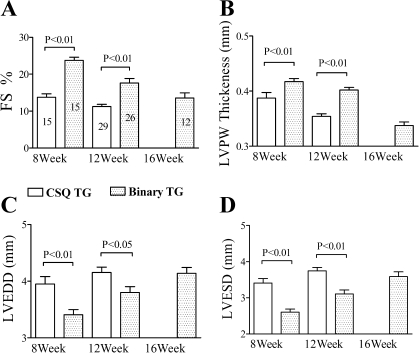Fig. 5.
A delay in the thinning of LV posterior wall (LVPW) is a novel feature of the rescuing effect in the binary heart. Two-dimensional-directed M mode echocardiography was carried out as described in Fig. 4 legend. The various echocardiography measures were summarized in CSQ and binary mice as means and SE. The number of mice studied in each genotype is indicated within each column. A: FS showed progressive decline in both CSQ and binary animals as they aged. Between successive age groups, the FS was different in both genotypes (8W CSQ vs. 12W CSQ, P < 0.05; 8W binary vs. 12W binary vs. 16W binary was also significant between any pairs of comparison, P < 0.05, 1-way ANOVA followed by posttest comparison). 8W and 12W binary hearts showed better FS than CSQ hearts of corresponding ages (P < 0.05). 16W binary hearts had similar FS as the 12W CSQ hearts (P > 0.1). B: LVPW thickness was characterized. A slowing of the LV wall thinning was also seen in the binary hearts. Results identical to those in A were obtained when LVPW thickness was compared between successive age groups in each genotype and when wall thickness was compared in binary versus CSQ mice. Again, by 16W, the LVPW thickness had declined and became similar to that found in 12W CSQ hearts (P > 0.1). LV dimension at end diastole (LVEDD; C) and at end systole (LVESD; D) also showed progressive increases in each genotype. Results identical to those in A were obtained when either LVEDD or LVESD was compared between successive age groups in each genotype and when these LV dimensions were compared in binary versus CSQ mice. By 16W, the LVEDD or LVESD had declined and became similar to those found in 12W CSQ hearts (P > 0.1).

